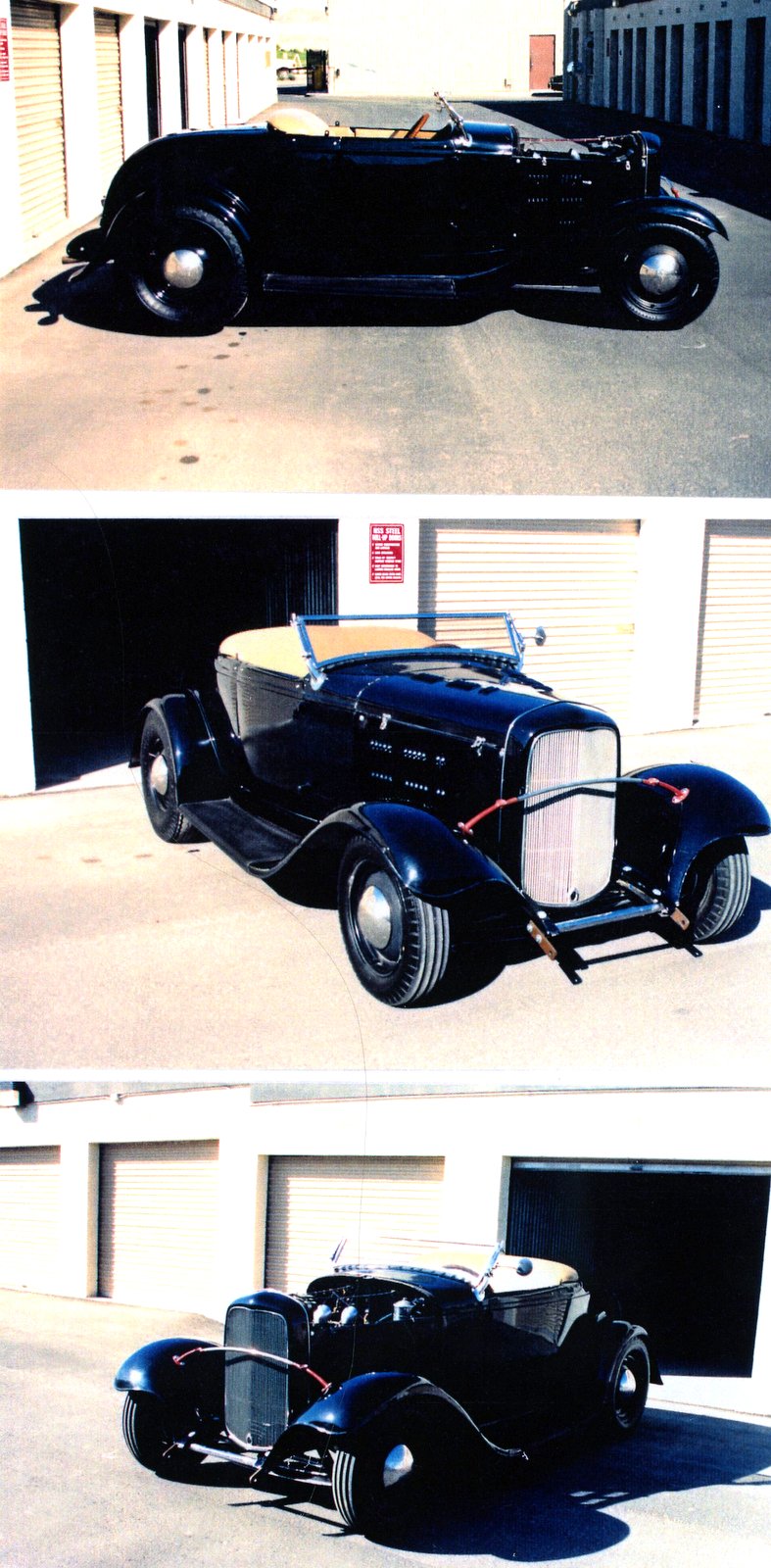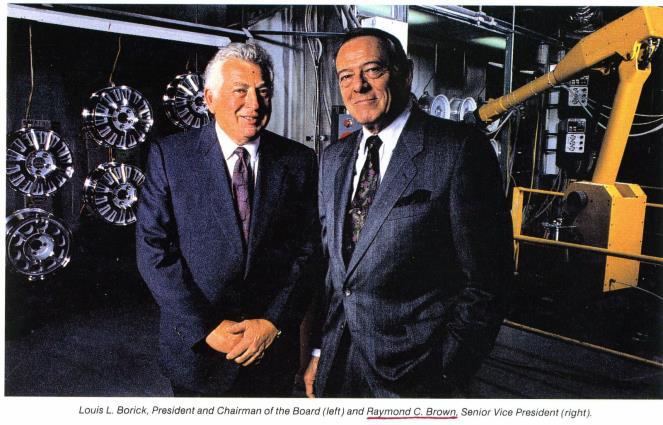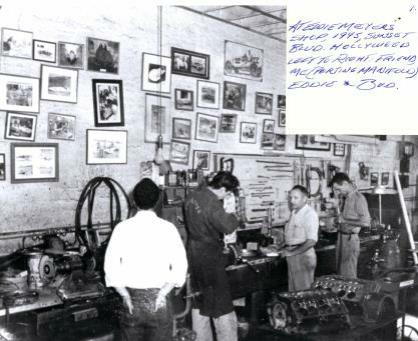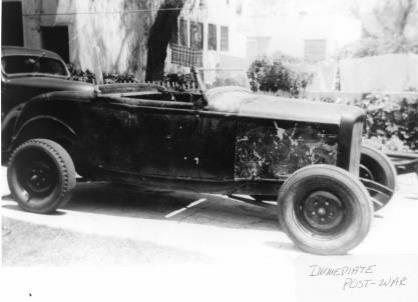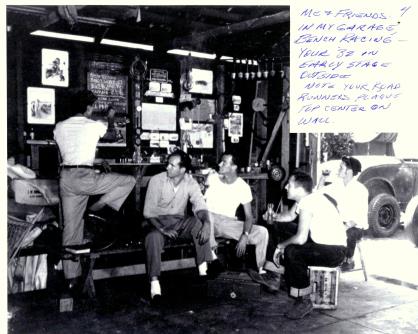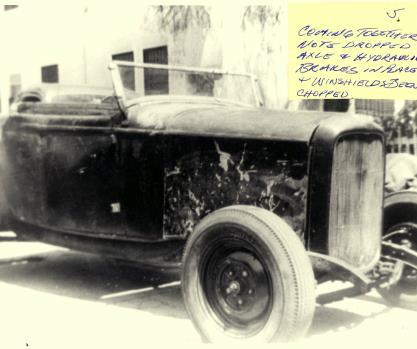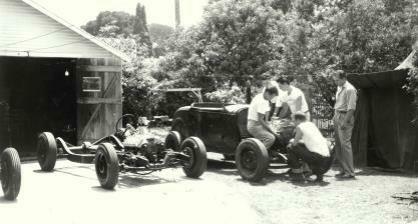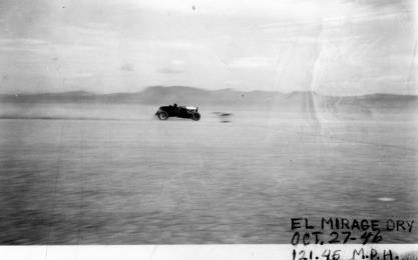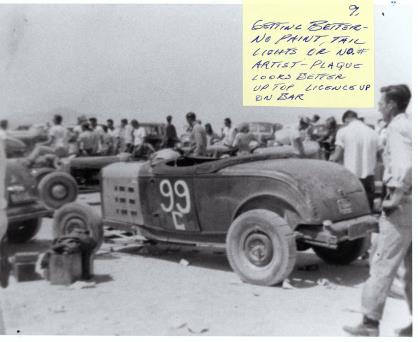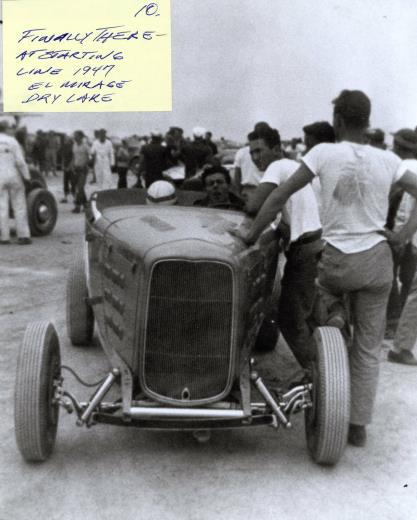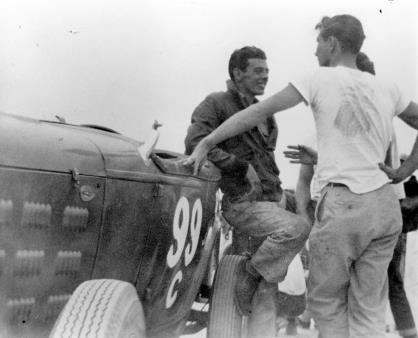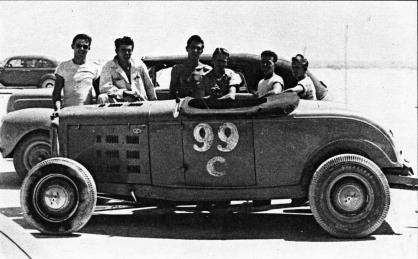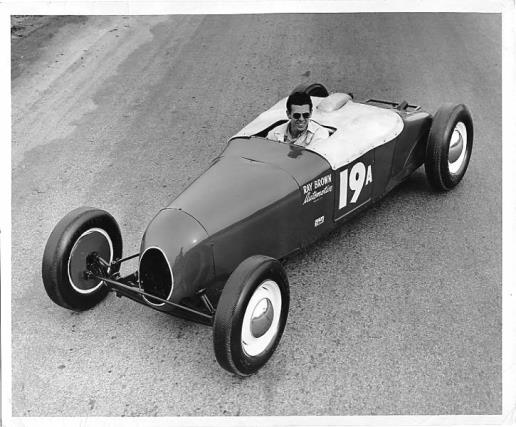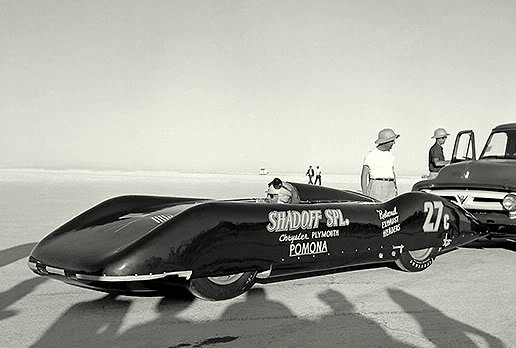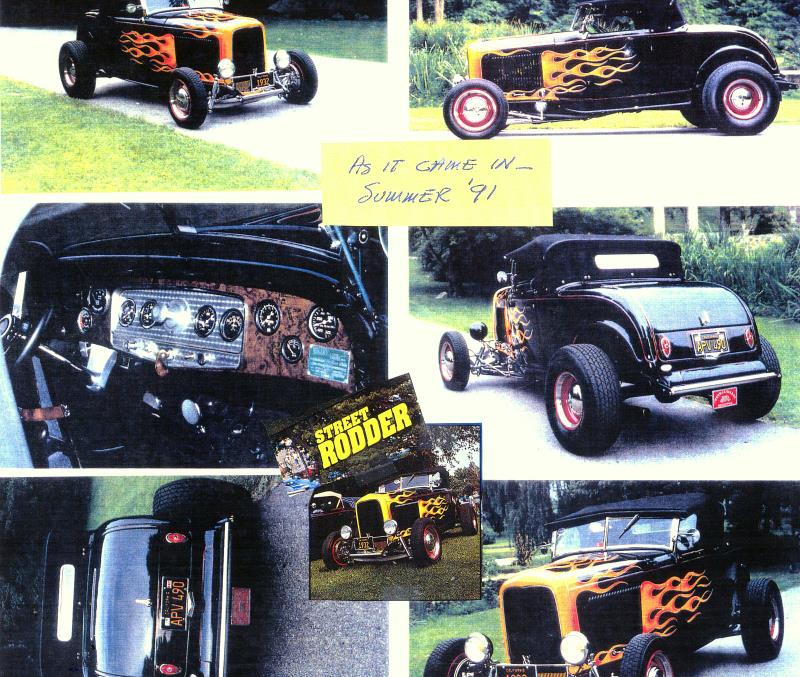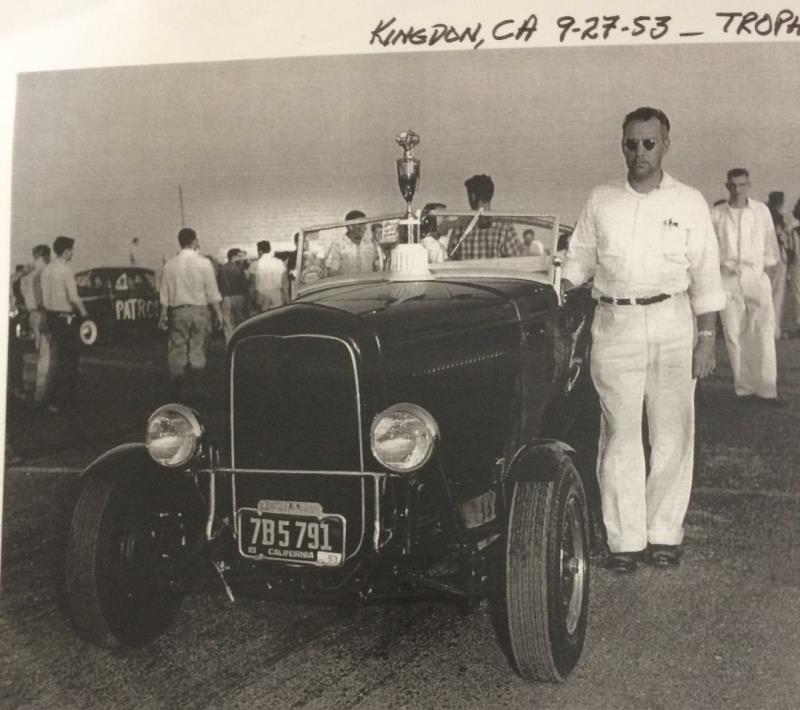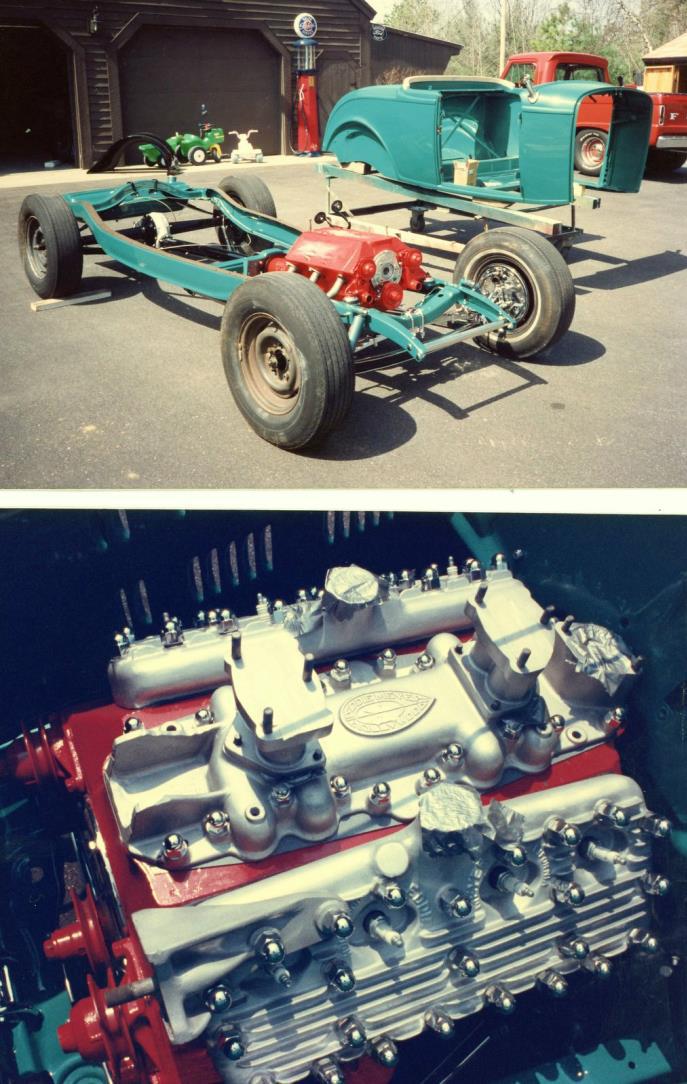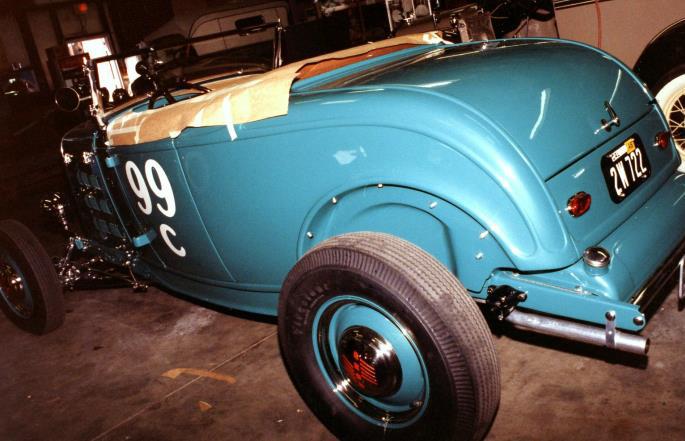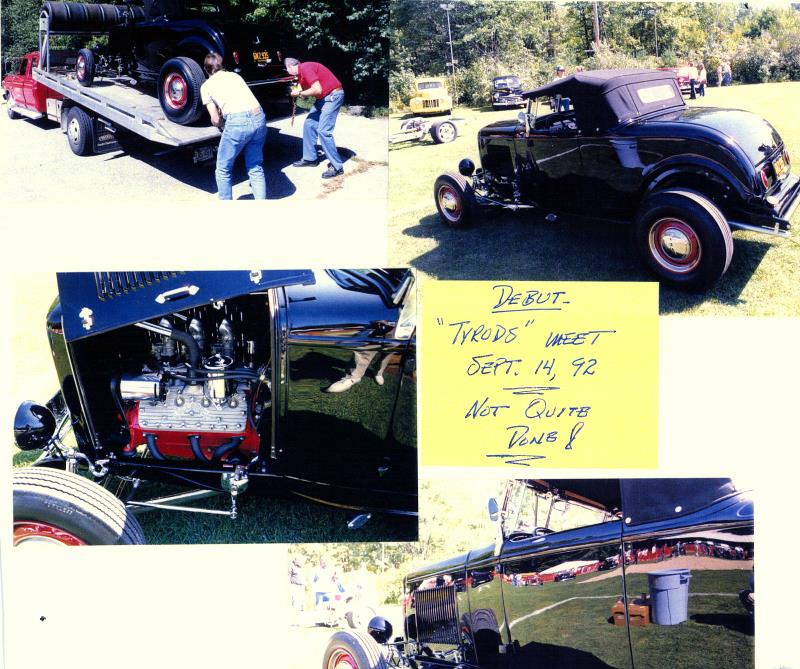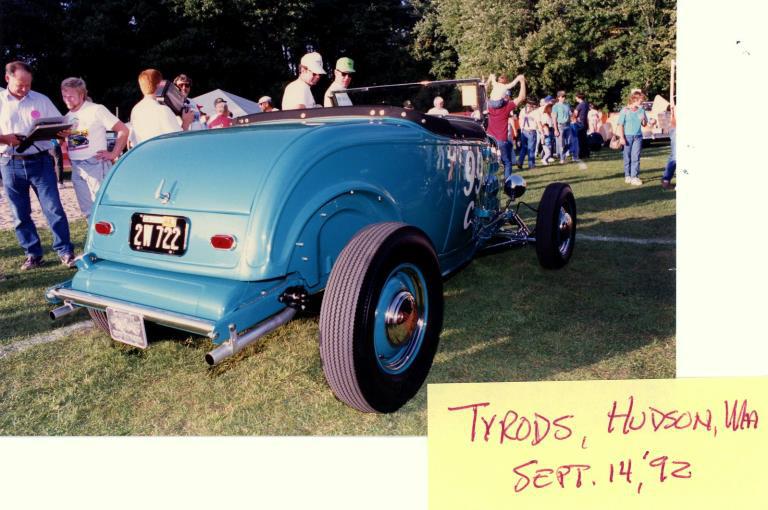808
You may recall at the close of Chapter 30, I was dealing by telephone with an “iceman” who was selling a 1932 Ford hot rod out of a long term storage garage in Las Vegas, Nevada.
In calling the owner I again found myself dealing with a dark voice that offered very sparse conversation and even less in the way of details pertaining to his 1932 Ford roadster.
It essentially came down to:
“Look, its $28,000 in cash or move along . . .”
And, “Yeah, the car is here in Las Vegas . . .”
That seemed to expend his verbal output for the day . . .
In researching the well illustrated Don Montgomery early hot rodding books, I had already determined that the original owner almost certainly, was a teenage Ray Brown during the period when Ray worked for “Eddie Myer’s Speed & Power Shop.” in Hollywood California!
At that time, right after World War II, Eddie’s 0peration was a “house of speed” to be reckoned with. A lot of really rapid machinery had come out of Myer’s shop.
Eddies gifted employee, Ray Brown at age 16 was running his own ’32 Ford roadster on the dry lakes at El Mirage in 1945, ‘46 and ‘47. The hot rod was very well built and had also served as Brown’s daily driver! El Mirage was a six mile long dried out lake bed, 30 miles east of Palmdale, California which was a long drive from Hollywood!
So, based on the three piece hood louver pattern that I was looking at in the Montgomery books, and the dreadful images from Mr. Stamper, who was the current owner, here’s what I did:
Chapter 31
809
“Subject to seeing your car with my eyes, I’ll buy your hot rod.” I told him.
I told Mr. Stamper that, purely by chance, I had to be in Los Angeles that Thursday evening, and I’d route my trip through Las Vegas.
(. . . Are you accusing me of a falsehood?? I can’t tell you how many times in my searches, when an apparent “prize” surfaced, I had to be right next door to the owner in the next 2,3,4 days . . .)
Stamper said he would meet me at the airport.
( . . . And, yeah, in the nineties, if you could scare up $28,000 in cash, you could get on a damn airplane with it.)
I was so stoked about possibly getting the car that late that Thursday morning found me stepping off an airplane in the Las Vegas airport. During the long flight I had spent a good deal of the time trying to absorb the fact that this trip may yield my first really significant racing hot rod.
As we pulled up to the gate it dawned on me that I didn’t even have a clue as to what Robert Stamper looked like!
But as I was standing uncertainly just inside the gate area, a tall rangy cowboy type tipped his hat and quietly asked if I was Kirk White.
He said he was Bob Stamper’s brother and Bob would meet us in front of the airport. I wasn’t expecting to be met by a character that looked like he was a tall “no nonsense” cowboy.
Outside the terminal a dusty white pickup drove up. The “brother” opened the passenger door and a serious character behind the wheel simply stated that he was Bob Stamper.
The brother urged me to sit in the middle of the bench seat, with Stamper driving, and the big cowboy brother next to me. I felt somewhat crowded and yes, a bit apprehensive.
Not a lot was said. Small talk from me wasn’t gaining any real traction. Either a one word answer or no response from either brother.
810
I had never been to Las Vegas before. We drove out of the airport complex and then proceeded to drive and drive, and drive.
The drive became inordinately lengthy and finally, I leaned forward a bit and glanced in the large outside passenger door mirror.
I watched as the Las Vegas city skyline slowly disappeared in the mirror!
Oh, fuck . . .
Suddenly I was worried, then very worried and very still.
It was one of those (. . . “You’re in trouble, Whitey . . .) episodes.
I was sitting there between these two dead serious western cowboys with my eastern boy’s briefcase, that as much as shouted out in flashing lights:
“$28,000 CASH . . .Right in here!!”
It was beginning to appear I may well be kissing my $28,000 in cash good bye. Every bit of the episode so far was developing into a scenario that clearly indicated I was toast.
Just how simple minded could one jackass be?
This had to be among the easiest cons ever perpetrated. It was so incredibly simple, that I didn’t see how these two “brothers” could actually keep from bursting out in gales of laughter.
I was sure they couldn’t believe that this bozo had walked, no, had run, into this set-up!
Then the question in my head became, “what are they going to do with me after they’ve grabbed the money?”
I was so scared at that point that I could scarcely move. I stopped glancing at the outside mirror. There was nothing to view.
Finally at the furthest reaches of the desert the truck turned into a vast storage locker area and my fear turned into stark terror.
811
How double simple: Grab his money, finish him off and lock him in a remote unit. No one would ever turn him up.
The truck stopped, Stamper and his brother got out of the truck and approached a unit. I could barely function at that point.
The storage door went up and there, in fact, sat a 1932 Ford roadster. Neither brother was brandishing a firearm . . .
There are no words for the relief that swept through me at that point. My knees very nearly buckled.
It was the Ray Brown roadster alright, just as you see it in the photographs below which were taken just as it rolled out into the light of day . . .
That roadster just stepped out of that garage and as much as said: “You’re looking at a real, “no nonsense” American hot rod, son!”
Sure, the car was more than somewhat down at the heels. But the further I delved into the car, the better it got. It was definitely the Ray Brown ’32 Ford. The engine appeared to be original, the interior was a mess and the gauges were all goofy. Yet the car had a very clever secondary, dedicated, alcohol system. But, where the hell did those fenders come from . . .??
Stamper knew the car had been sold to a man who moved to the east and it sat in the back of a Ford dealership in western Pennsylvania where the owner had worked.
The gentleman retired and moved from Pennsylvania to Las Vegas. It had been stolen by a group of teenagers. When it was recovered, the interior and the top assembly were gone. A bit more mystery was added to the mix as somewhere along the way the hot rod had acquired a full set of ’32 Ford fenders!
812
Oddly, the Southern California Timing Association club plaque remained intact on the trunk.
Then, as I was looking the car over, a pickup truck drove past the end of the row of storage units and I heard the driver slam on his brakes, pitch it in reverse and back up hard.
The guy turned his truck up our row and accelerated toward us. He braked hard, jumped out of the truck and was all over the hot rod!
“Is this for sale?” the guy asked.
My nerves bristled.
Bob Stamper merely said: “No, it’s not.”
Before it was all over a second guy had shown up with the same question. And just to cap it all off the Kruse brothers were holding a big auction in Las Vegas that weekend, so there were car guys all over Vegas!
Damn, this hot rod was going to put me in the grave before I ever got it home!
I paid Bob Stamper and the brothers dropped me back at the airport.
I needed to get that hot rod stashed away as quickly as possible. At the airport I called Dave Wilson at Intercity Lines. I knew they would have trucks at the Kruse auction. Dave said someone would collect the Ray Brown roadster that afternoon, put it “upstairs” in one of their cross country trailers, and he would be sure the car would be all the way forward, and covered up.
By the time I got off the airplane in Philadelphia the roadster was safely ensconced high in the nose of the upper deck of an Intercity truck.
I telephoned Jim Lowrey, Sr. in Chelmsford, Massachusetts. (I, of course had bought my great “first” 1932 Ford hot rod from Jim.)
Both Jim and his son Jim, Jr. already had an amazing reputation with the antique and classic automobiles that they had restored, many of which had been early significant Fords. They had a spectacular record of coming out of their shop and straight to the top of the judge’s scoring sheets.
813
Yes, he and Jim Jr. would be interested in restoring the Ray Brown car, and yes, they could take the hot rod as quickly as I could get the car to them.
Intercity took the car straight into Jim Lowery’s place in Chelmsford, Massachusetts.
THE SAGA OF A LIFETIME . . .
In buying the roadster from Bob Stamper, I had no idea that in a very short period of time, I was soon to experience the saga of a lifetime.
Back in Philadelphia, I tentatively formulated a plan . . . Based on the car’s racing history on the California Dry Lakes, I wanted to qualify the Ray Brown hot rod for recognition in the Antique Automobile Club of America’s Class 24-A for genuine “no nonsense” racing cars.
I contacted Lynn Paxton and Jim Etter. Both were familiar with and had extensive experience the Antique Automobile Club of America’s, Class 24-A. They felt the car certainly had the credentials and should qualify, but advised me to get ready for a bit of a challenge in attaining the 24-A badge.
A substantial number of AACA members simply disliked the ever increasing number of “Street Rods” that were being built, many of which had hopelessly and forever destroyed former “antique” automobiles, particularly early Ford roadsters. Some felt hot rodders in general were walking wrecking yards.
Yes, in the past the AACA had accepted a handful of antique drag racing cars and racing hot rods. I believe Ron San Giovanni with a altered bonafide dragster may have been the first. However, by 1990 it had become a quite difficult class to gain acceptance in. The qualification process had grown quite stringent.
814
Essentially the AACA wanted pure open wheel, largely American racing cars: the sprint, midget and Indianapolis 500 cars. There had even been resistance to the earliest NASCAR stock cars.
(“. . . Hell, those junkers ran on the damn sand down there in Florida. They ain’t nothin more than a bunch of old moonshine runners . . .”)
So, yes the 24-A crowd in the AACA at that point in time was more than a bit wary of American hot rods, Class 24-A or not.
And, to make my life a bit tougher, my entry would be based on one of Henry Ford’s most iconic and revered automobiles. The highly desirable 1932 Ford roadster!
Still, Ray Brown’s hot rod clearly qualified as a bonafide 24-A competition car with a more than a genuine racing history.
But, beyond what many people thought of hot rods and the “hoodlums” who ran them, I had seen firsthand living proof that the knowledge gained through early hot rod development, pushing out the edges of the performance envelope in all forms of contemporary automobile racing was extensive.
Just hitting the high spots, men like Carroll Shelby, Dan Gurney, Doane Spencer, Traco Engineering, Ray Brown, Alex Xydias, and Roy Richter, ad infinitum were all hard core hot rodders.
Even our Penske/White Ferrari 512M carried American hot rodding fingerprints all through it.
All that aside, I was strongly urged to go through the necessary qualification process.
Again, we would not be the first hot rodders to arrive, hat in hand, with a hot rod, but we could certainly expect the necessity for each “t” to be crossed and each “i” carefully dotted.
815
A WONDERFUL LIFE CHANGING TELEPHONE CALL . .
Then one evening I took a very long shot. I called Dean Batchelor. I hadn’t talked with Dean since our conversation in the seventies concerning historied competition hot rods. Dean was one of America’s greatest hot rodders, having truly “done it all.”
“Dean, I just purchased Ray Brown’s dry lakes ’32 roadster. Is Ray still around? Do you have any direction you can point me to possibly contact him or to someone who may have known something about him?”
“Here, I’ll give you Ray’s phone number, he’s right here in Southern California” offered Dean!
I called the number and Ray Brown answered! I introduced myself.
Occasionally in life, almost as soon as you’ve exchanged introductions, you know you’re talking with a really terrific, exciting, person.
Ray was amazed that I had turned up his old roadster and he was really pleased that the car was going to be restored, though he couldn’t quite understand why anyone would want to do such a thing with an old clapped out hot rod.
He had found the ’32 Ford roadster in a used car lot in 1945 right after the war as a “rolling” hot rod. It had no engine or interior. He and his pals started to build the old ’32 back into a hot rod as the very early photos show and they ran the “project” hot rod when they could afford the gas, etc.
When Ray turned 16 years old he was working part time in Eddie Meyer’s speed shop in Hollywood, he told me.
But, then came an astonishing part of our conversation. Ray Brown said he had quite a bit of saved material on the car.
Through all the years, Ray Brown had compiled and retained, an extensive file, including all manner of photographs of the car. It was as though he knew at some point the old hot rod would turn up one day!
816
We chatted a bit longer and I promised to keep him posted as we progressed with the restoration.
“Please, feel free to call me at any time” Ray said and he gave me all of his contact information.
At that point in time Ray was Executive Vice President of Superior Industries, the company that manufactured virtually all of the alloy wheels for the automobile industry in America!
(Okay, I know I know I do this all the time, but this is a great story . . .
In getting to know him better, I asked Ray how he had ended up with Superior Industries.
He told me he had worked with Carroll Shelby at a point in time where Carroll was closing his operation and literally as Shelby was closing the doors, he told Ray:
“If you can use all those alloy wheels back there, they’re yours . . .”
Ray Brown took them along and in the process of thinking through what to do with them; he was struck with an idea.
On a beautiful early December Saturday morning he boarded a plane and flew to Detroit. Upon arriving he noticed how damn cold it was in Detroit!
Ray hailed a taxi-cab and told the driver: “Ford Motor Company, please . . .”) .
He was suddenly freezing and the cabbie didn’t budge and was simply staring at Ray in his mirror.
“I need a little more than that buddy; there are thirty six Ford addresses in this town!”
817
Ray suddenly realized his trip may have benefitted from a bit better planning.
“Headquarters, Please . . .” Ray said, shivering.
The driver took him to the executive offices. Ray went through the door and was greeted by an empty lobby. It was a Saturday after all. But on the reception desk there appeared to be an office directory.
(Now this is where the story tumbles into la-la land . . . )
Ray went through the directory, located a name he recognized, and rang the guy’s number from the reception desk!
The “guy” answered and said to Ray: “I’d heard you’d gotten those wheels, come up to my office and let’s talk!”
They struck a deal and Ray was on his way in the specialty wheel business. In the photo below you’ll see how far he went. . .
I mean what the hell?? I made Ray tell the story again!
(. . . And, that folks is one of the best “Extra Effort” stories I have in my seemingly bottomless bag of tales. . .)
Back to our conversation, Ray casually mentioned he still had his 28 Timing Tags the car had won!
No, he did not want to give up the timing tags, but he said he would send a package of material to me that I might enjoy and that would be of help in what we were doing with the old racer . . .
Following that conversation I had a good head of steam and was anxious to push forward with this AACA certification.
818
Bill Smith was the Executive Director of the Antique Automobile Club of America at that time. I approached Bill relative to securing bulletproof paperwork to secure 24-A certification and he started me off in the right direction.
He advised me that it would be wise to get with Bill Wright. I went to Harrisburg and received good counsel from Wright. Bill was a true gentleman and I might add a fan of genuine American hot rods!
Shortly after talking with Bill Wright, I made arrangements to visit Ray Brown at his home in southern California.
At the end of the visit Ray gave me his entire file on the car. He showed me the 28 Timing Tags which he had strung on a long key chain, But again, no, he did not want to let go of them.
The Timing Tags aside, the photographs, notes and letters were priceless. Ray was a real historian. He had chronological 8x10 black and white photographs right from the inception of his ’32 Ford “Highboy” racer!
To cap it all off Ray had hand written and attached “post-it” notes to the photographs! I was thunderstruck! And, here are a good many of those old photographs . . .
819
What was the color of the car when Ray had it?
Where did the full fenders come from?
Did the car have a cockpit tonneau of some sort, as there were snaps all around the cockpit surround?
Two interesting stories came to light . . .
The Lowery’s had discovered a trace of what appeared to be a metallic green paint deep in a crevice of the car. I questioned Ray as to what color the car had been when he painted it.
“Sherwood Green” he responded with certainty, “it was a new Buick color that year.
(Groan, . . . a “Buick” color! WTF?. . .) My pal John Surotchak had brochures and factory info on every car on the planet. He came back quickly with a 1947 Buick sales brochure clearly indicating that indeed “Sherwood Green” was introduced in 1947. It was a “brightish” faint metallic green. You could get Sherwood Green only as a second tone of paint on a hardtop convertible model!!
Yes, Ray said, the car had run the lakes with a black canvas cockpit tonneau with an opening for the driver.
At the end of the 1947 season, Ray sold the car to a man who moved to Latrobe, Pennsylvania taking the hot rod with him. Ray went on to become one of the top builders of the iconic Ford V-8 flathead engines. He built and was very successful with rear engined racing cars and streamliners such as the two shown here.
The end of 1991 came and went. In the early spring, I visited the Lowery’s to brainstorm exactly the direction we’d go with the roadster. They too had been caught up in the fact that this was an important early American racing hot rod.
I would definitely follow their lead. I came away with some details that I needed to chase up. One question was: where did the goofy gauges spread all across the dash come from? And it would be my job to scare up a proper set of gauges.
Now, here’s where the story of this hot rod goes straight off the charts . . .
The legendary Doane Spencer was in the midst of his thirty eight state, uh, “tour” in his ’32 roadster. Some say it had been wise for Doane to take that good long trip to duck several law enforcement jurisdictions in southern California that wanted to serve him with more than a few speeding citations!
820
That bit of trivia aside, Doane was running skinny on funds when he happened upon a Ford agency in Latrobe, Pennsylvania. He secured employment there and met the man who had purchased the Ray Brown’s roadster. The Ray Brown hot rod was in a back corner of the Ford agency under some blankets.
Few people know Doane built his legendary ’32 roadster with full fenders! To raise some quick cash, he sold his fenders to the owner of the 99c car for $18!
So, that answered the fenders question.
The owner in Pennsylvania was the man who had badly changed out the original gauges. So, we were relieved to know that we could set the dashboard right with proper instruments.
Eventually, the owner in Latrobe retired and moved to Las Vegas. He had never carried out his plans for the ’32 roadster. It had spent most of its life in Latrobe under a bunch of blankets .
The final bit of drama for the old war-horse occurred when a group of thugs in Las Vegas stole the car. They vandalized the car a bit and gave it a joyride before abandoning it.
Stamper took possession of it at that time.
IF SOMETHING IS GOOD, CERTAINLY MORE MUST BE BETTER . . .
In that early summer of 1991 while I was at our home in Maine, I received a thick envelope from a gentleman named Bob Magane who lived in Massachusetts.
Bob was selling an all steel genuine old fifties hot rod that had been built in Stockton, California. The owner and builder had been Bob Schaeneman.
821
The car had been in the Oakland Roadster Show in 1954 and the dashboard carried a Timing Tag from Russeta Timing Association at 125 MPH.
The car had a very unique chopped split windscreen, wild flames licking through the entire nose and hood section, a small block Chevy, and pretty good sized wheels and tires.
Magane told me he had bought the car out west with a full house flathead and had driven the ’32 Ford roadster across the country. During the entire drive, Magane had been on edge about the reliability of the heavily modified Ford flathead motor. Once back in New England, Magane said he had continued to be wary of the flathead motor.
He went on to tell me the motor had been used to gain the timing tag on the car. He said Schaeneman and his buddies had electro-penciled the date and speed on the block!
(. . . seemed to me I’d heard that song before . . .) He’d sold the engine to a buddy of his in Chelmsford!
Suddenly I realized that the engine he was describing was the very engine that Jim Lowrey had installed in my hot rod which I had bought from Jim at Hershey and which I still owned!
I did everything I could to contain myself for the balance of the telephone conversation. He wanted $28,000 for the car.
What were the chances . . .??
(Just like Las Vegas, as pure luck would have it I was going to be in Bob Magane’s neck of the woods the day after tomorrow!!)
I called Jim Lowrey and he gave the Magane’s roadster a good send-off. It was the real thing, through and through.
I then began to push the edges of the envelope and asked Lowrey if I could ship my ’32 and Magane’s Schaeneman roadster to him to swap the engines out and then restore the Schanneman roadster back to its 1954 configuration.
822
Would Jim and his son be comfortable restoring both hot rods, side by side?
“Sure”, said Jim, Sr. and it was a really great summer watching those two historied hot rods being fastidiously restored to their respective original specifications.
Often automobile restorations are a more than tedious proposition. With the Lowery’s, it was a genuine pleasure from start to finish. An added bonus was having Ray Brown join in the process and provide so much input. He was right there with so much key information.
Two significant incidents come to mind. The first was a telephone conversation with Ray the day we were removing the engine from his roadster to begin to tear it down for a careful rebuild.
“When you pull the heads off, Ray said, I will be able to tell you if it is the same engine that I ran at the very end of the 1947 season, just before I sold the car to that fellow who took it on out to Pennsylvania.
“The port and relieve job on my engine was done by Manny Ayulo. If it is mine, you’ll see that Manny always cut the relief area almost square.” And sure enough, when we pulled the heads back, it was definitely Ayulo’s work.
Later, when it came time to accurately fit the racing canvas tonneau over the cockpit, we could see a few remaining “lift-a-Dot” studs.
Ray was able to tell me over the phone exactly where all of them should be located!!
The Lowery’s moved steadily through the restorations.
In the meantime, I was deep into getting both cars approved for acceptance into Class 24-A, the Antique Automobile Club of America’s class for bonafide competition cars.
There was a good deal of paperwork to qualify and there were moments when I wanted to throw up my hands. I thought, this is too much like schoolwork!
823
But finally, we sailed out the other side of it and received Class 24-A designations.
John Surotchak had sent us a Buick sales brochure and Sherwood Green was a match for the bit of the paint that had turned up on a wheel edge of Ray Brown’s car.
Joe Mahoney of Carson’s paint worked tirelessly with Glasurit Paints to precisely match the very, very, fine metallic green color.
I moved Heaven and Earth turning up the correct dashboard instruments.
Lastly LeBaron Bonney’s top man came up and did the racing tonneau cover.
THE TYRODS ANNUAL MEETING 1991 . . .
In the New England area, actually Hudson, Massachusetts, a hard core group of hot rodders hold their annual get together on the Monday afternoon a week after Labor Day! They start it late in the day, and charge you plenty of money to come through the gates. Finally, if they don’t really care for the look of you or the look of your car, you won’t make the cut!
The Lowery’s always looked forward to attending that show and were working hard to get the two hot rods there, unannounced. They would surely be a knock-out surprise. The pictures show the arrival of the cars. The first to be placed was the Schaeneman roadster. Then the two Jim’s went back to get the 99 car.
A great swoop of attendees descended on the car, several trying to peer at the engine through the hood louvers with little success.
So, being a good and sharing guy I said:
“Here let me open the hood so you can get a better look . . .”
What I didn’t see was the fact that the two Jim’s had returned, and the old man was rapidly approaching the car. He quickly closed the hood and turned to me and hissed:
“You don’t raise that hood! The damn engine isn’t wired yet!!”
No one had jeered or snickered or frankly even noticed that there were no spark plug wires . . .
I got a slight indication that the cars may be reaching a point where they were no longer mine . . .
But that’s silly isn’t it? Well, isn’t it. . . ??
OFF TO HERSHEY, 1992 . . .
In Chapter 32 we’ll take you through that amazing weekend where we introduced the cars . . . plus more than a few additional adventures!


